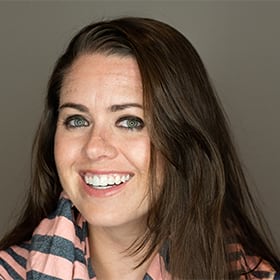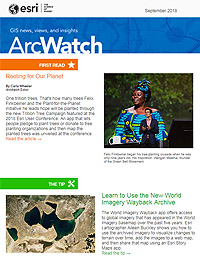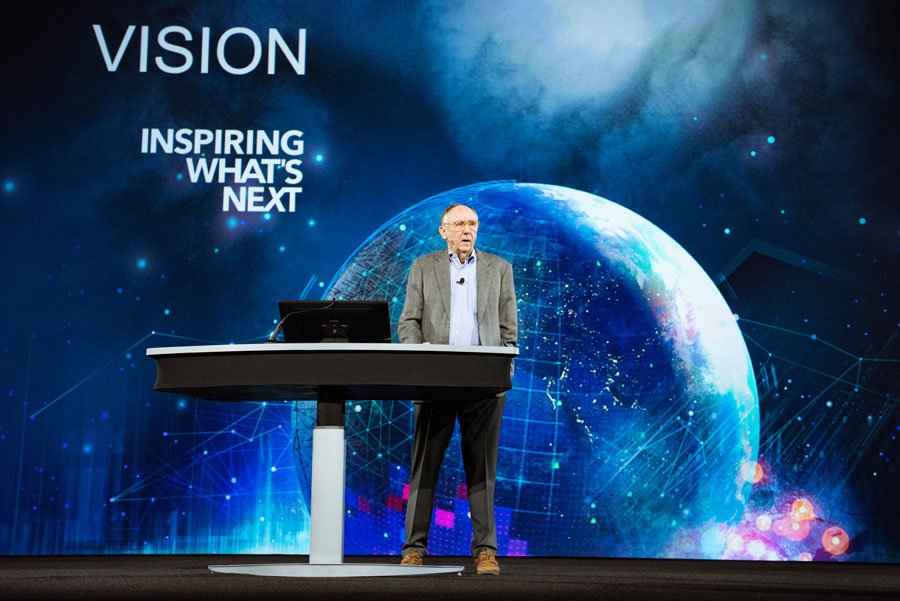
The theme of this year’s Esri User Conference (Esri UC), Inspiring What’s Next, had a two-pronged focus: to discover what’s next in the world of GIS technology and to contemplate what’s next for our world.
“I would like to start this conference by having you ponder what’s next for our planet,” Jack Dangermond said at the Plenary Session of the Esri UC, which drew close to 18,000 people to San Diego, California, for a week in July. “And, in turn, what does that mean for you personally, and what does that mean for you in terms of your organization, your family, and your community?”
The planet is under pressure, with increasing urbanization, social conflict, overpopulation, climate change, and deforestation. “The pace of change is accelerating almost exponentially, and for us, it’s creating many challenges—threatening our natural world, clearly, and some would say threatening our future as human beings,” Dangermond said.
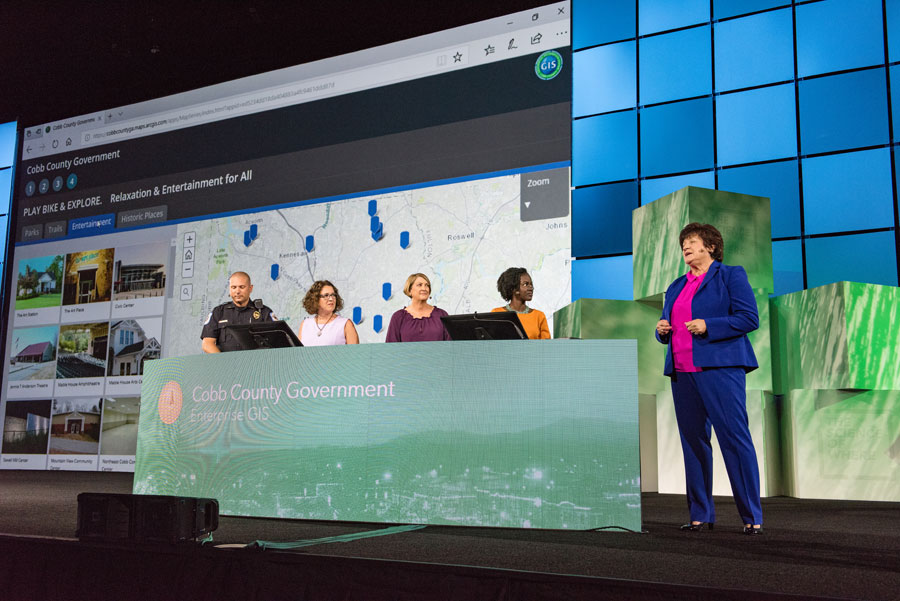
From Dangermond’s perspective, all these issues need to be addressed by gaining a better understanding of problems, collaborating on solutions, and then acting. GIS is central to that.
“It’s about applying the power of digital geography to create a better future,” Dangermond said. “This starts with envisioning what’s possible and then looking at all the things that you are actually doing and accelerating them—improving efficiency, making cities smarter, protecting biodiversity, and integrating environmental thinking into virtually everything we do.”
More than a dozen people took the stage to illustrate how their organizations use geospatial technology to design better cities, operate more efficiently and sustainably, protect precious ecosystems, and train tomorrow’s resource-conscious workforce. This group of people are truly enriching what’s next.
Inspiring Collaborative Government
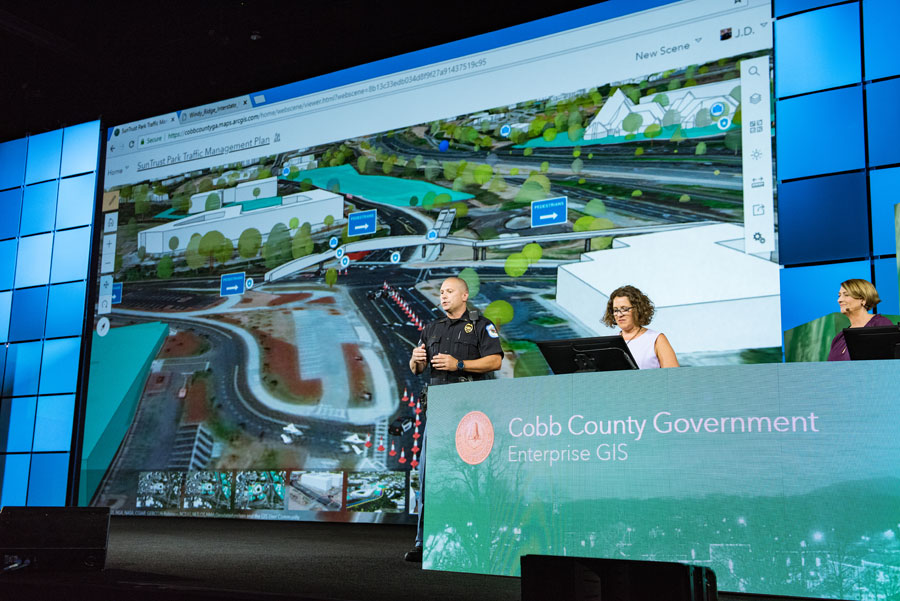
Cobb County, Georgia, employs an extensive enterprise GIS to make its region more prosperous, resilient, and vibrant. The county’s information services department still aspired to do more.
“We wanted to build on what we already had and make GIS easy enough and visible enough that anyone could use it to solve their problems—even a non-GIS professional,” said Sharon Stanley, director of information services for Cobb County.
Once staff got the attention of county executives by using an Esri Story Maps app to promote a distillery tour, the use of GIS began to spread swiftly.
Felicia Alingu, the outcomes program specialist for Cobb Senior Services, had never used the technology before. But she took the Insights for ArcGIS training class that her GIS department offered, and she immediately recognized the software’s usefulness.
“Cobb Senior Services has five multipurpose senior centers, and it’s my job to help others understand our impact on Cobb’s older adults,” explained Alingu.

With Insights for ArcGIS, Alingu can easily communicate how valuable the county’s senior centers and their programs are to the thousands of seniors who use them each year. Dragging client data onto a map, she can see where the seniors live; which centers they go to and how often; and which activities, such as bingo, are the most popular.
“By 2030, one in three Cobb residents will be age 55 or [over], and the older adult population will be more diverse than ever,” Alingu said. “Collaboration with the GIS department helps us find underrepresented groups so that we can work harder to engage all of the county’s older adults.”
Engaging commuters is a big focus for Lynn Biggs, the GIS manager for the Cobb County Department of Transportation (DOT). She showed the audience Cobb Commute, a GIS-based mobile app that provides users with road status information so that they can see, in real time, whether any accidents or road construction projects could affect their travel.
The DOT also uses GIS to look for ways to improve roads. Reviewing three years of accident data on cars that had hit big objects such as utility poles, Biggs showed how the DOT used a geoprocessing tool to confirm that hills and curves are major factors in these types of crashes.
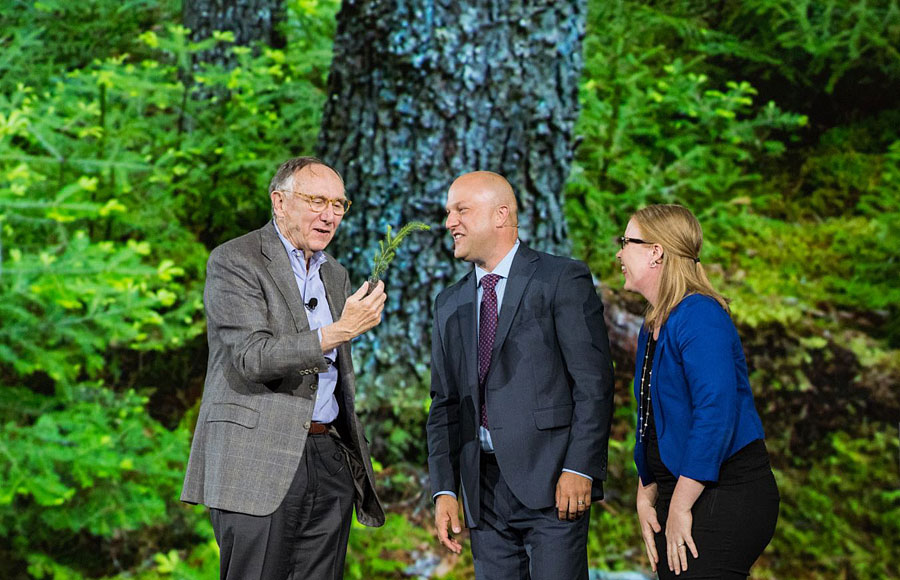
“We can now actively look for roadway improvement projects to specifically address fixed-object crashes,” concluded Biggs.
Being proactive, Cobb County built a digital twin of an area in its jurisdiction that is undergoing significant development: SunTrust Park—the new home of the Atlanta Braves baseball team—and its adjacent business center, The Battery Atlanta.
Working with an array of Esri partners to get lidar data and other imagery, Cobb County used ArcGIS Pro to construct the digital twin. Now, multiple divisions can use it to see, measure, and analyze details both inside and outside the 41,500-seat stadium.
The police department, for example, used the digital twin to come up with a comprehensive traffic management plan that gets all fans parked before the first pitch and returns traffic to normal flow within 45 minutes of a game ending.
At the end of each game, Lieutenant J. D. Lorens from the Cobb County Police Department monitors the flow of pedestrians exiting the stadium. Lorens uses a dashboard that shows maps, charts, and live security camera footage. With all this information readily available, he knows exactly when to change the traffic lights to red at a certain intersection to minimize pedestrian pileups and vehicle queues.
“We successfully manage traffic at the interchange between two of the busiest interstate corridors in the entire southeast,” Lorens said. “As a police officer, I never imagined that the platform our GIS professionals utilized would also make me and my team achieve a higher level of success.”
Inspiring Precision Forestry
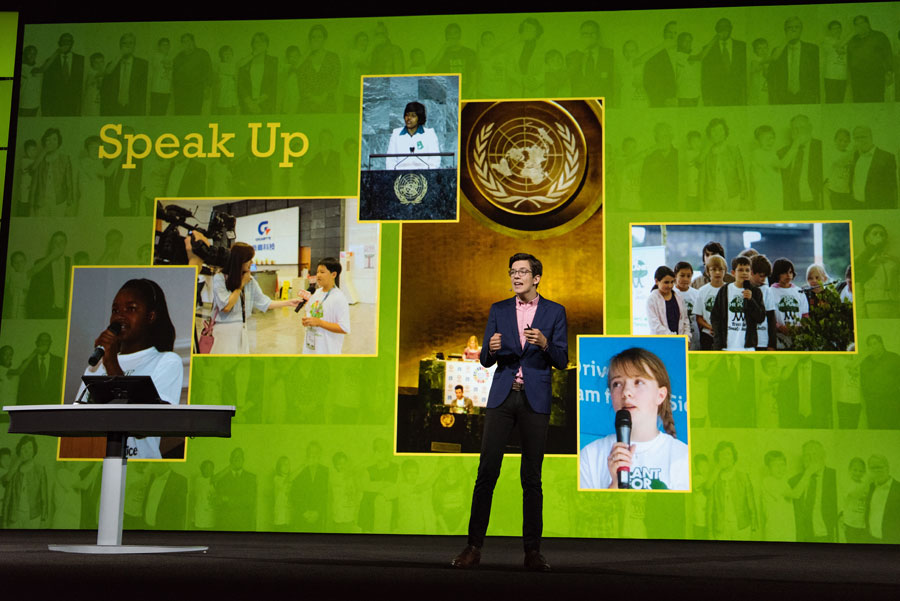
Geospatial technology also can be used to make companies sustainable. One such organization is J.D. Irving, Limited (JDI). Headquartered in Canada, its operations include hydro energy, shipbuilding, agriculture, and retail, but its roots are in forestry.
The family-owned company manages six million acres in Canada and the United States, with a substantial portion of that land dedicated to producing forest products such as lumber, paper, and toilet tissue. JDI started using GIS in 1984 to manage its land records efficiently. Now the company employs the technology as a digital platform for business intelligence, using a hyperaccurate lidar scan of its forest to propel smarter decision-making.
“Over the last few years, we’ve been investing in precision forestry,” said chief forester Jason Killam. The lidar scan of the forest has transformed supply chain processes, tracing JDI’s merchandise from seedling to final product.
Using ArcGIS Pro, Killam showed in 3D how the company gains insight into the land and its health.
“We realized early on [that] we needed a novel way to really organize this…big spatial data,” he said. “We did this using modeling, random forest algorithms, and the statistical package R to organize our data on 20-meter grid cells, all totaling 200 million grids.”
JDI has a precise inventory of its land that shows tree volume, the percentage of live crown on the trees, and even the depth of the subsurface water table. Now, the company can use location intelligence to automate how foresters make complex decisions, such as when to harvest certain trees and where. JDI can employ GIS to prioritize forest areas that need commercial thinning, excluding any lands set aside for conservation. JDI can easily find the volumes of logs, stud wood, and pulpwood that are ready to harvest and be delivered to the mills.

Heather Morrison, GIS lead for JDI, said that foresters can also take this data into the field on tablets using Explorer for ArcGIS.
“They are excited to have all our data at their fingertips [when] n remote locations without cell coverage and definitely no Wi-Fi,” she said.
This allows JDI to determine the ground truth of areas that are planned for commercial thinning, which helps trees continue to grow healthily.
“For instance, if I am in the field and see a bird’s nest that we want to protect, I can note it so the plan can be modified,” said Morrison.
Later this year, JDI will plant its billionth tree. To commemorate that, Morrison and Killam presented a spruce seedling to Dangermond, who was impressed by how the company has embraced digital transformation.
“They are an incredible company and have values,” he said. “And they’ve integrated the concept of environmental thinking into everything [they] do.”
Inspiring the Trillion Tree Campaign
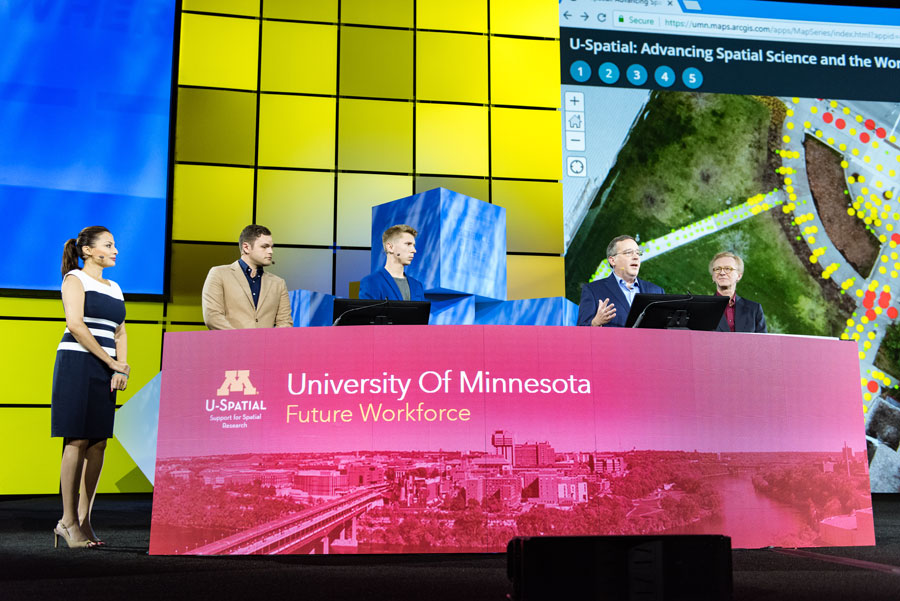
While JDI is close to planting its billionth tree, the Plant-for-the-Planet Initiative, with support from the United Nations Environment Programme, has planted more than 15 billion trees worldwide. The organization recently launched the Trillion Tree Campaign, which aims to plant 1 trillion additional trees.
As part of that campaign, Plant-for-the-Planet acquired 55,598 acres on the Yucatán Peninsula in Mexico and hired 100 employees who plant about 6,000 trees per day. This tree planting program is supported by companies that want to be carbon neutral, said Felix Finkbeiner, founder and chairperson of the Plant-for-the-Planet Initiative, who spoke at the Plenary Session.
Finkbeiner said that the survival rate of trees being planted in tree planting projects in the area was, on average, only 22 percent after the first year. However, the Plant-for-the-Planet Initiative has realized much better results.
“We plant these trees with a survival rate of not 22 percent but 94 percent,” he said. “We do so at the cost of one Euro per tree. And that includes [the costs] of our tree nursery and planting for these trees and caring for these trees as they mature.”
The Yucatán project has been a resounding success largely because it follows best tree planting practices and heeds the scientific advice of global system ecologist Tom Crowther, an assistant professor at ETH Zürich and head of the Crowther Lab there.
Crowther’s research revolves around climate change and its impact on biodiversity—which includes the loss of trees and animals—and the regulatory systems that manage the planet.
The best current plan to reduce global warming, according to Crowther, involves managing human emissions, since those account for up to 10 gigatons of carbon per year in industrialized parts of the world. But ecosystems like forests can help too.
“They’re the lungs that draw down carbon from the atmosphere, and they store it in the soil,” said Crowther.
Improving the carbon sequestration capacity of forests needs to be done carefully, however, because trees may be restored in the wrong ecosystem or planted in the wrong soil.
“When [the trees] fall and die, those soils get degraded and nutrients are lost,” Crowther said.
To find out more about the ecological consequences of planting trees around the world, the Crowther Lab is mapping tree size and density as well as the species identities of various forests. Crowther and his team are also cataloging the world’s soils to try to identify the ones that can best support new trees.
“If we manage these ecosystems effectively, there’s room for an additional 1.2 trillion trees,” said Crowther.
And that is where Finkbeiner’s Trillion Tree Campaign comes in. The two believe that having one trillion more trees on earth could capture up to 150 gigatons of carbon.
Onstage, Dangermond announced that Esri would contribute to planting 60,000 trees for the Trillion Tree Campaign, offsetting the carbon footprint of the Esri UC attendees’ travel to San Diego and making the 2018 Esri UC carbon neutral.
“Fantastic!” exclaimed Finkbeiner.
Inspiring a New Geospatial Workforce
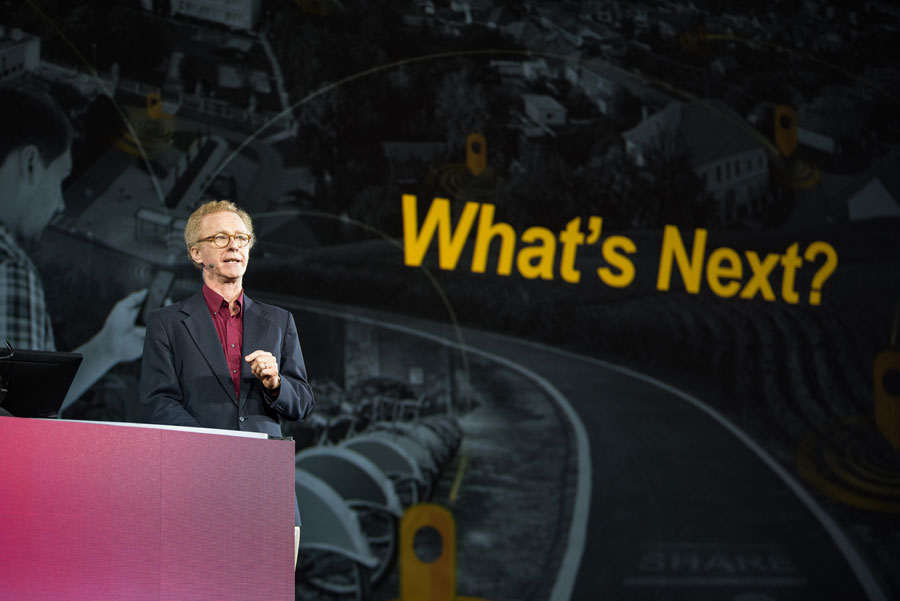
Planning sustainable communities, running governments and businesses efficiently, and restoring forests all depend greatly on a well-trained workforce. Today, that means people who are knowledgeable about GIS, remote sensing, geodesign, and spatial computing.
The U-Spatial program at the University of Minnesota is a leader in training students, faculty, researchers, and staff in geospatial technologies.
“Nearly every discipline uses GIS to enhance the three-pronged mission of higher education—teaching, research, and outreach,” said Len Kne, associate director of U-Spatial. “Each year, 1,000 [students at the University of Minnesota] are enrolled in ArcGIS courses. And more than 6,300 students, faculty, and staff have named user accounts on ArcGIS Online.”
At the Plenary Session, Kne joined some university students and faculty in demonstrating how geospatial technology gives them an edge. He showed how the university uses enterprise GIS to “manage a city within a city”—conducting sidewalk inspections, for example, and giving that mapped information to campus facilities.
Students then demonstrated their own projects. Coleman Shepard, a student in the university’s geographic information science master’s program, showed the audience how he used Sentinel-2 imagery from ArcGIS Living Atlas of the World, along with ArcGIS Pro, Jupyter Notebook, and Python, to study clusters of earthquakes near the erupting Kilauea volcano in Hawaii.
“Observing these clusters over time, we are able to clearly see that the cluster of earthquakes near the caldera is continuing to increase,” Shepard said. “By extracting publicly available data on geodetic stations, I was able to measure the displacement of land over time.”
Using Jupyter Notebook, Shepard also calculated that the North Pit GPS station, which monitored data for the United States Geological Survey at the volcano’s rim, had dropped more than 65 feet.
Professor Thomas Fisher, director of the Minnesota Design Center at the University of Minnesota, concluded the presentation by asking the audience to look at what’s next for the workforce that U-Spatial is helping to train. Fisher envisions a more nomadic future in what is increasingly becoming a sharing economy.
“Mobile devices, spatial tools, [and] digital apps are allowing us to live more lightly on the planet—to access what we need without having to own it, and to pay for only what we use,” he said, citing companies such as Airbnb, Uber, and TaskRabbit as examples of this fast-growing economy.
Companies like those, Fisher said, are “squeezing out the inefficiencies of the twentieth century,” when too many goods were produced and too many resources were consumed. He anticipates that the sharing economy will free up land and resources to help people live more sustainably—but only if they are spatially informed.
“Spatial thinking is absolutely central to this new economy, helping us access goods and services and . . . identify underutilized assets that can be used to form community-sharing services that build local economies and expand the capacity of local governments,” Fisher said.
He then issued a call to action to the audience.
“Every boardroom, every council chamber, every corner office,” he said, “needs the skills of spatial analysts and geodesigners to map the opportunities that exist and to make these unseen connections that will help our communities thrive.”
Watch all the presentations from the Esri UC Plenary Session.
Esri writer Matt Ball contributed to this report.
